Event Report:
Psychedelic Science in the 21st Century
Jun 2010
Citation: Various Authors. "Psychedelic Science in the 21st Century". Erowid Extracts. Jun 2010;18:4-7.
MAPS' Psychedelic Science in the 21st Century conference (April 15-18, 2010, San Jose, California) was a great opportunity to learn about the current state of research into psychedelics and meet with others interested in this field. This bustling event was packed with more than 1,100 attendees and featured over 80 speakers.
Erowid Center ran an information booth at the conference, where we fielded questions related to psychoactives, registered new and renewing members, distributed flyers, and shared an advanced copy of Sasha Shulgin's forthcoming book The Shulgin Index. Erowid also hosted a hospitality suite where members could relax and converse in a pleasing aesthetic environment. The suite was decked out chill space-style with elaborate altars, lots of pillows, and showcased paintings from the visionary artists Actual Contact, Tom Swanson, and Vibrata Chromodoris. Animated socials were held in the evenings, with snacks and drinks.
The following comments about the conference are from Erowid supporters and volunteers. Photos by Erowid.
The "ayahuasca track" was a mixture of health sciences, social sciences, and trip reports. Among tables, statistics, tough sociological debates, and prayers to Mother Earth, most rooms were at full capacity throughout the conference. The panels included topics such as ayahuasca as psychological therapy, its effect on cognition and mental health, its use in the treatments of addiction and cancer, its relationship to spirituality, arts and music, public policies relating to its use, and so forth. The presenters--psychologists, psychiatrists, workshops facilitators, anthropologists, doctors, disciples, teachers, public policy administrators, writers, and even a politician--were mainly from the United States and Canada, but more distant places were also represented, including Brazil and Europe.
Some talks were not academic in nature, but rather reflections of the practitioners on their own experiences, or institutional presentations by ayahuasca retreat centers. In fact, these seemed to be the most popular talks in the track, eliciting questions such as: "I drank ayahuasca and felt pain, what does this mean?"
"I took ayahuasca and slept, why does this happen?" "Why did I have such a vision?" "I had this trauma in my childhood and I wonder if taking ayahuasca could help me overcome this?", etc. This gave a strange flavor to a conference that identified itself as scientific and aimed to create political legitimacy for the use of psychedelic medicines. The awkward questions posed by the public underscored the lack of institutional or intellectual space to properly discuss the challenges of the worldwide expansion of ayahuasca use.
Although these parts of the track seemed to have a non-scientific, self-help spirit, one could argue that by accommodating such diverse audiences and presenters MAPS is also helping to develop a culture of public education and awareness about the use of ayahuasca, while giving professionals such as psychotherapists a rich view of the concerns of individuals who use ayahuasca.
The ayahuasca track concluded with a packed meeting of researchers. At one point, a Shuar shaman spoke for a long time and played the flute. While some seemed enchanted, others left while he had the stage. The opposite reactions to the native man's unexpected participation reflected the variety of interests present in the conference and exemplified its hybrid nature.
It is a given that many conference attendees' initial interest in psychedelics was sparked not by therapeutic or medical use, but by recreational use. It's also worth noting that most psychedelics are illegal because of recreational use, not because of therapeutic, medical, or even spiritual use. This contradiction persists.
We heard a variety of speakers discussing how MDMA and traditional psychedelics can be used as medical or therapeutic agents, while others addressed their sacramental use. But even if current research establishes some psychedelics as having medical, therapeutic, or spiritual utility, this does not mean that we will see any movement toward full legalization per se, as long as recreational use is still considered personally or socially harmful.
Nor is there unanimity among psychedelic researchers that broad-based legalization is the best approach. Some assert the principle of "cognitive liberty" while others worry about psychological, sociological, and physiological impacts of unsupervised, irresponsible, or prolonged use.
In this community, this debate exists even for cannabis, so imagine a discussion of what to do with a substance like ketamine, which clearly has medical utility, possibly has therapeutic utility, and is viewed by many psychonauts as being ontologically interesting, yet also has the potential for addiction.
What, then, is the best regulatory framework possible for psychedelic drugs? This question came into focus a number of times during the presentations, but few if any answers were proposed.
I arrived somewhat late the first day, but in time to be thoroughly impressed with Andrew Weil. His talk on the potentials of psychedelics was wide-ranging, funny, detailed, and totally extemporaneous. His wonderment at the thin segment of research being done, primarily around treating anxiety, was eye-opening. He reported on LSD having been used to eliminate allergies, alter pigmentation, reduce inflammatory response, and trigger focused genetic change. These experiences, and other anecdotes, leave Weil thinking that we've not yet hit first gear in psychedelic research.
Dave Nichols conducted an informal poll, to see how many audience members found the latter portions of their LSD experiences to be marred by paranoia or anxiety. Having written extensively about my own travails, I was relieved to see 15-20% of the audience raise their hands. This concurred with Nichols' estimations, and his research into a liver enzyme released some time between the fourth and sixth hours of LSD digestion, which apparently causes limbic disturbance. Discussing this with a fellow attendee, it was suggested that grapefruit juice might prevent assimilation of that enzyme, which could mean a whole new perspective on LSD for perhaps 20% of its would-be consumers.
I bullied my way to the front for James Kent's eye-opening lecture "The Mechanics of Hallucinations", which (although marred by cross-platform PowerPoint difficulties) elucidated the relationship between neural network switching related to rod and cone vision, visual information processing rate, and the brain's pattern-recognition function. Apparently, when overloaded with visual information, the brain switches control of the visual input to the brain areas responsible for creating dream imagery, which can overlay directly on top of open-eye information. All this, plus the witty bravado that makes Kent who he is!
The Erowids should be mentioned for their meticulous sociological research into use patterns surrounding newly evolving substances that are based on cannabinoid analogs. Their two-headed approach allowed them to interchangeably deliver the play-by-play facts and color commentary, which in this case described the history of Spice, its user-reported effects, market size estimates, legal backlash, and the subsequent whack-a-mole explosion of imitations, all while questioning the thinking of those who've turned imitation cannabis of unknown quality or composition into a multimillion dollar industry.
The Shulgin tribute dinner was a heartwarming and very satisfying event. It stands out as the most memorable moment of the conference. Stan Grof's workshop was A+. The whole gathering had a nice friendly feeling, competition wars for grant money seemed to be at an all-time low, and there was a hint of unity and harmony not seen since the sixties throughout the entire spectrum of hippies, freaks, and medical/psychiatric experts in the field.
For me, the event was about the people who gathered there. While we all know that there is a worldwide interest in psychedelics, it was very reassuring to actually be among such a large number of like-minded people. Looking back at the weekend, I realize that I now know dozens of new people who I think of as friends. My favorite moment was to be together in person--for the first time since 1999--with four of the five founding members of the Psychedelic Salon, which originally was an online voice chat group. My sincere thanks to the entire MAPS staff who put this event together; and in particular, my love and gratitude to the Erowid crew.
Any gathering of the Tribe is a good thing. This one was a real advance, in that it presented the use (as opposed to abuse) of the sacraments in a positive light. But I don't have to tell you that. I was skeptical at first, but the MAPS crew pulled it off in a way that successfully surfed the interface between an epochal event and a media circus. Kudos to them.
The best presentation by far was that of Julie Holland, talking about her ER adventures, and how she has been able to advance the art of psychedelic therapy within the NY medical system. At the same time, I was appalled at the fact that she was not given nearly enough time to present her stuff and would have given a much better talk if she didn't have to motormouth it in a desperate manner.
Moments! Where do I start? Giving Sasha the love that he deserves, even if he might be past the point of assimilating it all properly. Getting in touch with many old friends and making countless new ones. Discovering people who are following the same path, or even just fellow travelers. And it was all a great party, even for a person such as myself who doesn't know how to have a good time. Being a bartender at the Erowid hospitality suite was, for me, the fulfillment of a dream.
A glowing, inspiring, thought-provoking coming together of the community--truly, a watershed event. While distracted by the sheer amount of interacting I did with other attendees, I managed to fit in a few sessions. I particularly liked the ayahuasca talk wherein a gentleman explained how the brain works on psychedelics: in a slowed down state. Some talks were fairly dry and generally put folks to sleep, as is often the case in presentations of scientific papers where the speaker doesn't know how to engage an audience.
A key moment for me was during the Shulgin tribute banquet, when it became clear that a strong, diverse, yet singular community was present in the room. Our past, present, and future all seemed to radiate out from that moment in the ballroom at the funky Holiday Inn in North San Jose. I sensed that the community had attained a sort of viability, where we would be able to rally if called, to defend any member who came under attack. Something was beginning anew. I was wearing a scarf that Timothy Leary had worn in the years before his death, to bring the spirit and original intent of those perhaps somewhat misguided and misfortunate early pioneers back to the space where it is being reborn.
When looking at the top MAPS people I felt as if I were looking at used car dealers: a necessary evil? Funding and all, I saw a lot of hungry eyes; needing work, I guess?
Listening to Carolyn Garcia speak of meeting Neal Cassady, seeing Nick Sand, and hearing Earth and Fire mention Terence McKenna and experiencing the subtle irony of their talk--that's what I came for, and I was fulfilled. Also, the ayahuasca track had something special; it seems that "medicine" can produce a kind of humbling experience, which was reflected in what I heard there.
All in all, the potential harvesting of the hungry masses that flooded the event was unpleasant. Thank God for Mountain Girl, Nick, Earth and Fire. I really miss Terence and others. Also, bless the Shulgins. I'm not completely comfortable with MAPS and the potential profit motive, along with the star-trip/desperate-$-ego-trip. Oh well. It may be the way of the world at this time, and it's just what I felt.
I thought the coolest and most hopeful lecture was the "silent lecture" delivered repeatedly during the conference in the main hall. I am referring to the short intermittent blacking-out of PowerPoint slideshows, despite the expertise of the audio-visual techs. As it persisted, I detected a hint of an accent to the silent Morse code, and after a wee bit recognized the mischievous rhythm being offered to all of us by the Irish Lads of Psychedelic Science: Timothy Leary and Terence McKenna. I think that they were showing us that they couldn't be kept away from such a paradigm-shifting conference.
Erowid Center ran an information booth at the conference, where we fielded questions related to psychoactives, registered new and renewing members, distributed flyers, and shared an advanced copy of Sasha Shulgin's forthcoming book The Shulgin Index. Erowid also hosted a hospitality suite where members could relax and converse in a pleasing aesthetic environment. The suite was decked out chill space-style with elaborate altars, lots of pillows, and showcased paintings from the visionary artists Actual Contact, Tom Swanson, and Vibrata Chromodoris. Animated socials were held in the evenings, with snacks and drinks.
The following comments about the conference are from Erowid supporters and volunteers. Photos by Erowid.
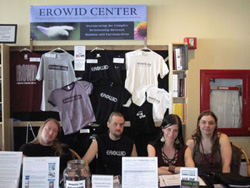
|
Things I Wouldn't Have Known About if I'd Missed This Event
by Mark Kleiman
- There's evidence that MDMA and MDE can help some people with autistic-spectrum disorders.
- There's evidence that ultra-low (non-psychoactive) doses of a hallucinogen called DOI can interrupt the inflammatory process implicated in both allergy and auto-immune disorders such as lupus.
- There's evidence that barely psychoactive doses of psilocybin can provide temporary relief from OCD symptoms in some patients.
- The trials of MDMA in the treatment of refractory post-traumatic stress disorder and of psilocybin in helping people deal with possibly terminal illness are producing impressive results.
- Lots and lots of serious science is going on, much of it using cutting-edge brain imaging, and younger scientists are starting to be willing to make career commitments to this long-marginalized research enterprise.
- Procedures for "guiding" in therapeutic settings are currently becoming manualized.
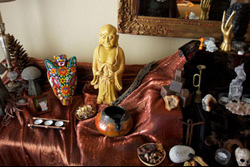
|
Thoughts on the Ayahuasca Track
by Beatriz Caiuby Labate and Clancy CavnarThe "ayahuasca track" was a mixture of health sciences, social sciences, and trip reports. Among tables, statistics, tough sociological debates, and prayers to Mother Earth, most rooms were at full capacity throughout the conference. The panels included topics such as ayahuasca as psychological therapy, its effect on cognition and mental health, its use in the treatments of addiction and cancer, its relationship to spirituality, arts and music, public policies relating to its use, and so forth. The presenters--psychologists, psychiatrists, workshops facilitators, anthropologists, doctors, disciples, teachers, public policy administrators, writers, and even a politician--were mainly from the United States and Canada, but more distant places were also represented, including Brazil and Europe.
Some talks were not academic in nature, but rather reflections of the practitioners on their own experiences, or institutional presentations by ayahuasca retreat centers. In fact, these seemed to be the most popular talks in the track, eliciting questions such as: "I drank ayahuasca and felt pain, what does this mean?"
"I took ayahuasca and slept, why does this happen?" "Why did I have such a vision?" "I had this trauma in my childhood and I wonder if taking ayahuasca could help me overcome this?", etc. This gave a strange flavor to a conference that identified itself as scientific and aimed to create political legitimacy for the use of psychedelic medicines. The awkward questions posed by the public underscored the lack of institutional or intellectual space to properly discuss the challenges of the worldwide expansion of ayahuasca use.
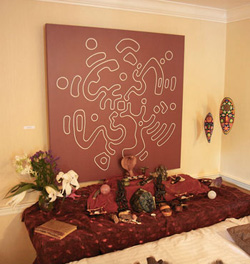
in Erowid hospitality suite |
The ayahuasca track concluded with a packed meeting of researchers. At one point, a Shuar shaman spoke for a long time and played the flute. While some seemed enchanted, others left while he had the stage. The opposite reactions to the native man's unexpected participation reflected the variety of interests present in the conference and exemplified its hybrid nature.
An Unresolved Question
by Jonathan TaylorIt is a given that many conference attendees' initial interest in psychedelics was sparked not by therapeutic or medical use, but by recreational use. It's also worth noting that most psychedelics are illegal because of recreational use, not because of therapeutic, medical, or even spiritual use. This contradiction persists.
We heard a variety of speakers discussing how MDMA and traditional psychedelics can be used as medical or therapeutic agents, while others addressed their sacramental use. But even if current research establishes some psychedelics as having medical, therapeutic, or spiritual utility, this does not mean that we will see any movement toward full legalization per se, as long as recreational use is still considered personally or socially harmful.
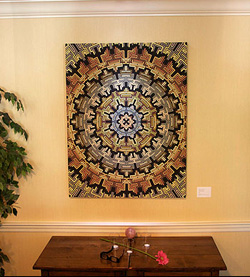
in Erowid hospitality suite |
In this community, this debate exists even for cannabis, so imagine a discussion of what to do with a substance like ketamine, which clearly has medical utility, possibly has therapeutic utility, and is viewed by many psychonauts as being ontologically interesting, yet also has the potential for addiction.
What, then, is the best regulatory framework possible for psychedelic drugs? This question came into focus a number of times during the presentations, but few if any answers were proposed.
On the Cutting Edge
by Sheldon NorbergI arrived somewhat late the first day, but in time to be thoroughly impressed with Andrew Weil. His talk on the potentials of psychedelics was wide-ranging, funny, detailed, and totally extemporaneous. His wonderment at the thin segment of research being done, primarily around treating anxiety, was eye-opening. He reported on LSD having been used to eliminate allergies, alter pigmentation, reduce inflammatory response, and trigger focused genetic change. These experiences, and other anecdotes, leave Weil thinking that we've not yet hit first gear in psychedelic research.
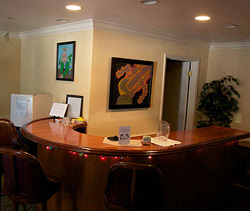
in Erowid hospitality suite |
I bullied my way to the front for James Kent's eye-opening lecture "The Mechanics of Hallucinations", which (although marred by cross-platform PowerPoint difficulties) elucidated the relationship between neural network switching related to rod and cone vision, visual information processing rate, and the brain's pattern-recognition function. Apparently, when overloaded with visual information, the brain switches control of the visual input to the brain areas responsible for creating dream imagery, which can overlay directly on top of open-eye information. All this, plus the witty bravado that makes Kent who he is!
The Erowids should be mentioned for their meticulous sociological research into use patterns surrounding newly evolving substances that are based on cannabinoid analogs. Their two-headed approach allowed them to interchangeably deliver the play-by-play facts and color commentary, which in this case described the history of Spice, its user-reported effects, market size estimates, legal backlash, and the subsequent whack-a-mole explosion of imitations, all while questioning the thinking of those who've turned imitation cannabis of unknown quality or composition into a multimillion dollar industry.
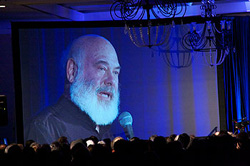
|
A Harmonious Success
by Nick SandThe Shulgin tribute dinner was a heartwarming and very satisfying event. It stands out as the most memorable moment of the conference. Stan Grof's workshop was A+. The whole gathering had a nice friendly feeling, competition wars for grant money seemed to be at an all-time low, and there was a hint of unity and harmony not seen since the sixties throughout the entire spectrum of hippies, freaks, and medical/psychiatric experts in the field.
Time with Friends
by Lorenzo HagertyFor me, the event was about the people who gathered there. While we all know that there is a worldwide interest in psychedelics, it was very reassuring to actually be among such a large number of like-minded people. Looking back at the weekend, I realize that I now know dozens of new people who I think of as friends. My favorite moment was to be together in person--for the first time since 1999--with four of the five founding members of the Psychedelic Salon, which originally was an online voice chat group. My sincere thanks to the entire MAPS staff who put this event together; and in particular, my love and gratitude to the Erowid crew.
Gathering of the Tribe
by Thomas Seeger

|
The best presentation by far was that of Julie Holland, talking about her ER adventures, and how she has been able to advance the art of psychedelic therapy within the NY medical system. At the same time, I was appalled at the fact that she was not given nearly enough time to present her stuff and would have given a much better talk if she didn't have to motormouth it in a desperate manner.
Moments! Where do I start? Giving Sasha the love that he deserves, even if he might be past the point of assimilating it all properly. Getting in touch with many old friends and making countless new ones. Discovering people who are following the same path, or even just fellow travelers. And it was all a great party, even for a person such as myself who doesn't know how to have a good time. Being a bartender at the Erowid hospitality suite was, for me, the fulfillment of a dream.
Past, Present, and Future...
by AnonymousA glowing, inspiring, thought-provoking coming together of the community--truly, a watershed event. While distracted by the sheer amount of interacting I did with other attendees, I managed to fit in a few sessions. I particularly liked the ayahuasca talk wherein a gentleman explained how the brain works on psychedelics: in a slowed down state. Some talks were fairly dry and generally put folks to sleep, as is often the case in presentations of scientific papers where the speaker doesn't know how to engage an audience.

|
Psychedelic Used Car Salesmen
by NerWhen looking at the top MAPS people I felt as if I were looking at used car dealers: a necessary evil? Funding and all, I saw a lot of hungry eyes; needing work, I guess?
Listening to Carolyn Garcia speak of meeting Neal Cassady, seeing Nick Sand, and hearing Earth and Fire mention Terence McKenna and experiencing the subtle irony of their talk--that's what I came for, and I was fulfilled. Also, the ayahuasca track had something special; it seems that "medicine" can produce a kind of humbling experience, which was reflected in what I heard there.
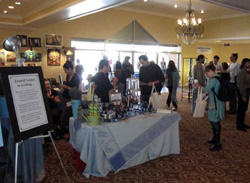
|
The Invisible Conference
by Leo FiggsI thought the coolest and most hopeful lecture was the "silent lecture" delivered repeatedly during the conference in the main hall. I am referring to the short intermittent blacking-out of PowerPoint slideshows, despite the expertise of the audio-visual techs. As it persisted, I detected a hint of an accent to the silent Morse code, and after a wee bit recognized the mischievous rhythm being offered to all of us by the Irish Lads of Psychedelic Science: Timothy Leary and Terence McKenna. I think that they were showing us that they couldn't be kept away from such a paradigm-shifting conference.

